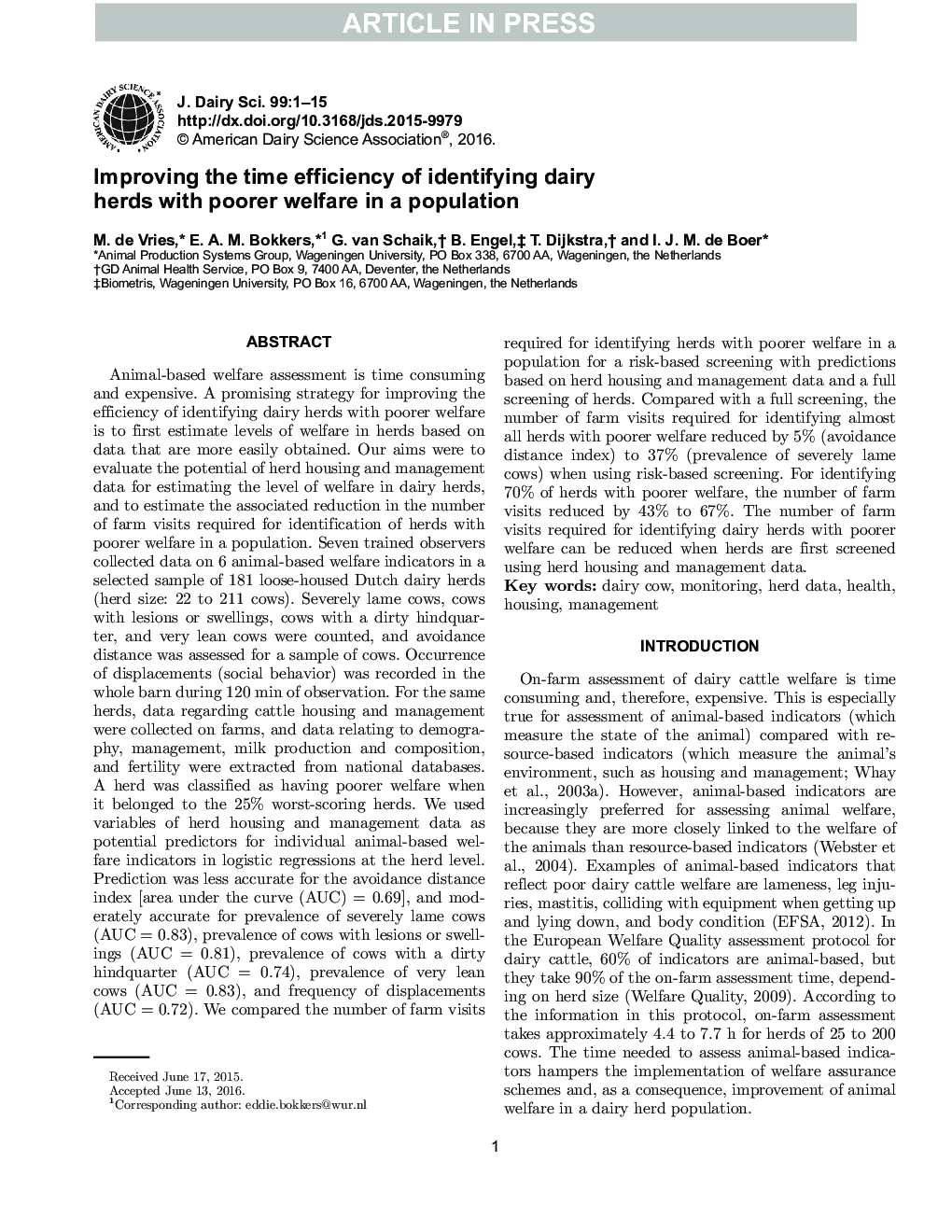| کد مقاله | کد نشریه | سال انتشار | مقاله انگلیسی | نسخه تمام متن |
|---|---|---|---|---|
| 5541861 | 1402511 | 2016 | 15 صفحه PDF | دانلود رایگان |
عنوان انگلیسی مقاله ISI
Improving the time efficiency of identifying dairy herds with poorer welfare in a population
ترجمه فارسی عنوان
بهبود کارایی زمان شناسایی گله های لبنی با رفاه فقیر در جمعیت
دانلود مقاله + سفارش ترجمه
دانلود مقاله ISI انگلیسی
رایگان برای ایرانیان
کلمات کلیدی
گاو شیری، نظارت بر، داده های گله، سلامتی، مسکن، مدیریت،
موضوعات مرتبط
علوم زیستی و بیوفناوری
علوم کشاورزی و بیولوژیک
علوم دامی و جانورشناسی
چکیده انگلیسی
Animal-based welfare assessment is time consuming and expensive. A promising strategy for improving the efficiency of identifying dairy herds with poorer welfare is to first estimate levels of welfare in herds based on data that are more easily obtained. Our aims were to evaluate the potential of herd housing and management data for estimating the level of welfare in dairy herds, and to estimate the associated reduction in the number of farm visits required for identification of herds with poorer welfare in a population. Seven trained observers collected data on 6 animal-based welfare indicators in a selected sample of 181 loose-housed Dutch dairy herds (herd size: 22 to 211 cows). Severely lame cows, cows with lesions or swellings, cows with a dirty hindquarter, and very lean cows were counted, and avoidance distance was assessed for a sample of cows. Occurrence of displacements (social behavior) was recorded in the whole barn during 120Â min of observation. For the same herds, data regarding cattle housing and management were collected on farms, and data relating to demography, management, milk production and composition, and fertility were extracted from national databases. A herd was classified as having poorer welfare when it belonged to the 25% worst-scoring herds. We used variables of herd housing and management data as potential predictors for individual animal-based welfare indicators in logistic regressions at the herd level. Prediction was less accurate for the avoidance distance index [area under the curve (AUC)Â =Â 0.69], and moderately accurate for prevalence of severely lame cows (AUCÂ =Â 0.83), prevalence of cows with lesions or swellings (AUCÂ =Â 0.81), prevalence of cows with a dirty hindquarter (AUCÂ =Â 0.74), prevalence of very lean cows (AUCÂ =Â 0.83), and frequency of displacements (AUCÂ =Â 0.72). We compared the number of farm visits required for identifying herds with poorer welfare in a population for a risk-based screening with predictions based on herd housing and management data and a full screening of herds. Compared with a full screening, the number of farm visits required for identifying almost all herds with poorer welfare reduced by 5% (avoidance distance index) to 37% (prevalence of severely lame cows) when using risk-based screening. For identifying 70% of herds with poorer welfare, the number of farm visits reduced by 43% to 67%. The number of farm visits required for identifying dairy herds with poorer welfare can be reduced when herds are first screened using herd housing and management data.
ناشر
Database: Elsevier - ScienceDirect (ساینس دایرکت)
Journal: Journal of Dairy Science - Volume 99, Issue 10, October 2016, Pages 8282-8296
Journal: Journal of Dairy Science - Volume 99, Issue 10, October 2016, Pages 8282-8296
نویسندگان
M. de Vries, E.A.M. Bokkers, G. van Schaik, B. Engel, T. Dijkstra, I.J.M. de Boer,
